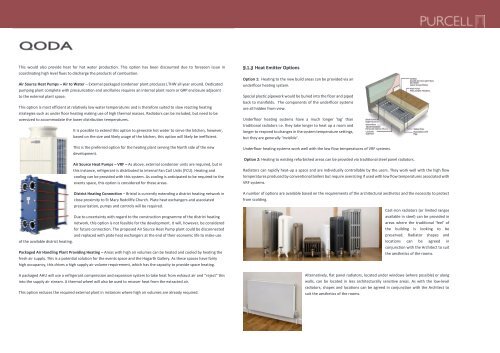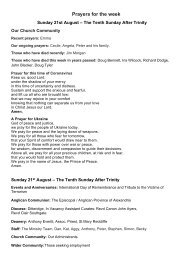St Mary Redcliffe Project 450 RIBA 2 Stage End Report
Create successful ePaper yourself
Turn your PDF publications into a flip-book with our unique Google optimized e-Paper software.
1563.R1 – <strong>St</strong>age 2 report Page 15 of 29<br />
This would also provide heat for hot water production. This option has been discounted due to foreseen issue in<br />
coordinating high level flues to discharge the products of combustion.<br />
Air Source Heat Pumps – Air to Water – External packaged condenser plant produces LTHW all year around. Dedicated<br />
pumping plant complete with pressurization and ancillaries requires an internal plant room or GRP enclosure adjacent<br />
to the external plant space.<br />
This option is most efficient at relatively low water temperatures and is therefore suited to slow reacting heating<br />
strategies such as under floor heating making use of high thermal masses. Radiators can be included, but need to be<br />
oversized to accommodate the lower distribution temperatures.<br />
It is possible to extend this option to generate hot water to serve the kitchen, however,<br />
based on the size and likely usage of the kitchen, this option will likely be inefficient.<br />
Heat Emitter Options<br />
Option 1: Heating to the new build areas can be provided via an<br />
underfloor heating system.<br />
Special plastic pipework would be buried into the floor and piped<br />
back to manifolds. The components of the underfloor systems<br />
are all hidden from view.<br />
Underfloor heating systems have a much longer ‘lag’ than<br />
traditional radiators i.e. they take longer to heat up a room and<br />
longer to respond to changes in the system temperature settings,<br />
but they are generally ‘invisible’.<br />
This is the preferred option for the heating plant serving the North side of the new<br />
development.<br />
Air Source Heat Pumps – VRF – As above, external condenser units are required, but in<br />
this instance, refrigerant is distributed to internal Fan Coil Units (FCU). Heating and<br />
cooling can be provided with this system. As cooling is anticipated to be required to the<br />
events space, this option is considered for these areas.<br />
District Heating Connection – Bristol is currently extending a district heating network in<br />
close proximity to <strong>St</strong> <strong>Mary</strong> <strong>Redcliffe</strong> Church. Plate heat exchangers and associated<br />
pressurization, pumps and controls will be required.<br />
Due to uncertainty with regard to the construction programme of the district heating<br />
network, this option is not feasible for the development. It will, however, be considered<br />
for future connection. The proposed Air Source Heat Pump plant could be disconnected<br />
and replaced with plate heat exchangers at the end of their economic life to make use<br />
of the available district heating.<br />
Packaged Air Handling Plant Providing Heating – Areas with high air volumes can be heated and cooled by heating the<br />
fresh air supply. This is a potential solution for the events space and the Hogarth Gallery. As these spaces have fairly<br />
high occupancy, this drives a high supply air volume requirement, which has the capacity to provide space heating.<br />
A packaged AHU will use a refrigerant compression and expansion system to take heat from exhaust air and “reject” this<br />
into the supply air stream. A thermal wheel will also be used to recover heat from the extracted air.<br />
This option reduces the required external plant in instances where high air volumes are already required.<br />
Underfloor heating systems work well with the low flow temperatures of VRF systems.<br />
Option 2: Heating to existing refurbished areas can be provided via traditional steel panel radiators.<br />
Radiators can rapidly heat-up a space and are individually controllable by the users. They work well with the high flow<br />
temperatures produced by conventional boilers but require oversizing if used with low flow temperatures associated with<br />
VRF systems.<br />
A number of options are available based on the requirements of the architectural aesthetics and the necessity to protect<br />
from scolding.<br />
Cast-iron radiators (or limited ranges<br />
available in steel) can be provided in<br />
areas where the traditional ‘feel’ of<br />
the building is looking to be<br />
preserved. Radiator shapes and<br />
locations can be agreed in<br />
conjunction with the Architect to suit<br />
the aesthetics of the rooms.<br />
Alternatively, flat panel radiators, located under windows (where possible) or along<br />
walls, can be located in less architecturally sensitive areas. As with the low-level<br />
radiators, shapes and locations can be agreed in conjunction with the Architect to<br />
suit the aesthetics of the rooms.


















